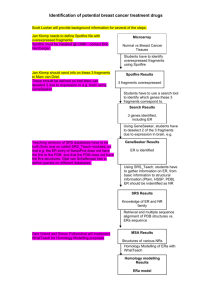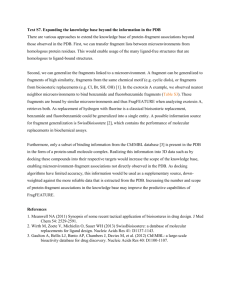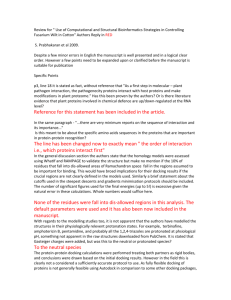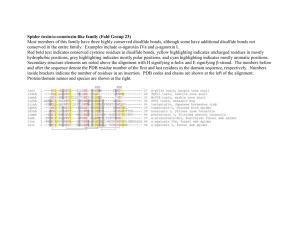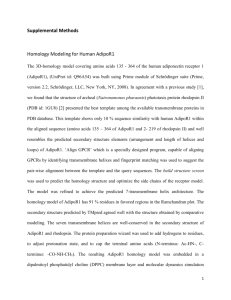Document 13308217
advertisement
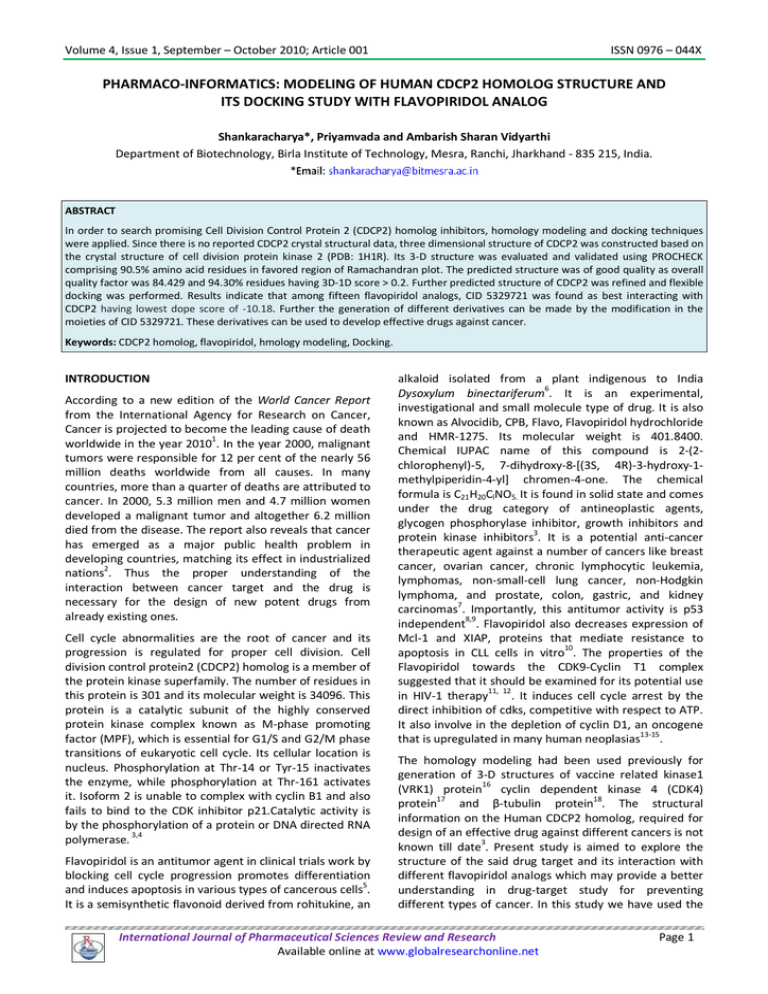
Volume 4, Issue 1, September – October 2010; Article 001 ISSN 0976 – 044X PHARMACO-INFORMATICS: MODELING OF HUMAN CDCP2 HOMOLOG STRUCTURE AND ITS DOCKING STUDY WITH FLAVOPIRIDOL ANALOG Shankaracharya*, Priyamvada and Ambarish Sharan Vidyarthi Department of Biotechnology, Birla Institute of Technology, Mesra, Ranchi, Jharkhand - 835 215, India. ABSTRACT In order to search promising Cell Division Control Protein 2 (CDCP2) homolog inhibitors, homology modeling and docking techniques were applied. Since there is no reported CDCP2 crystal structural data, three dimensional structure of CDCP2 was constructed based on the crystal structure of cell division protein kinase 2 (PDB: 1H1R). Its 3-D structure was evaluated and validated using PROCHECK comprising 90.5% amino acid residues in favored region of Ramachandran plot. The predicted structure was of good quality as overall quality factor was 84.429 and 94.30% residues having 3D-1D score > 0.2. Further predicted structure of CDCP2 was refined and flexible docking was performed. Results indicate that among fifteen flavopiridol analogs, CID 5329721 was found as best interacting with CDCP2 having lowest dope score of -10.18. Further the generation of different derivatives can be made by the modification in the moieties of CID 5329721. These derivatives can be used to develop effective drugs against cancer. Keywords: CDCP2 homolog, flavopiridol, hmology modeling, Docking. INTRODUCTION According to a new edition of the World Cancer Report from the International Agency for Research on Cancer, Cancer is projected to become the leading cause of death worldwide in the year 20101. In the year 2000, malignant tumors were responsible for 12 per cent of the nearly 56 million deaths worldwide from all causes. In many countries, more than a quarter of deaths are attributed to cancer. In 2000, 5.3 million men and 4.7 million women developed a malignant tumor and altogether 6.2 million died from the disease. The report also reveals that cancer has emerged as a major public health problem in developing countries, matching its effect in industrialized nations2. Thus the proper understanding of the interaction between cancer target and the drug is necessary for the design of new potent drugs from already existing ones. Cell cycle abnormalities are the root of cancer and its progression is regulated for proper cell division. Cell division control protein2 (CDCP2) homolog is a member of the protein kinase superfamily. The number of residues in this protein is 301 and its molecular weight is 34096. This protein is a catalytic subunit of the highly conserved protein kinase complex known as M-phase promoting factor (MPF), which is essential for G1/S and G2/M phase transitions of eukaryotic cell cycle. Its cellular location is nucleus. Phosphorylation at Thr-14 or Tyr-15 inactivates the enzyme, while phosphorylation at Thr-161 activates it. Isoform 2 is unable to complex with cyclin B1 and also fails to bind to the CDK inhibitor p21.Catalytic activity is by the phosphorylation of a protein or DNA directed RNA polymerase. 3,4 Flavopiridol is an antitumor agent in clinical trials work by blocking cell cycle progression promotes differentiation and induces apoptosis in various types of cancerous cells5. It is a semisynthetic flavonoid derived from rohitukine, an alkaloid isolated from a plant indigenous to India Dysoxylum binectariferum6. It is an experimental, investigational and small molecule type of drug. It is also known as Alvocidib, CPB, Flavo, Flavopiridol hydrochloride and HMR-1275. Its molecular weight is 401.8400. Chemical IUPAC name of this compound is 2-(2chlorophenyl)-5, 7-dihydroxy-8-[(3S, 4R)-3-hydroxy-1methylpiperidin-4-yl] chromen-4-one. The chemical formula is C21H20ClNO5. It is found in solid state and comes under the drug category of antineoplastic agents, glycogen phosphorylase inhibitor, growth inhibitors and protein kinase inhibitors3. It is a potential anti-cancer therapeutic agent against a number of cancers like breast cancer, ovarian cancer, chronic lymphocytic leukemia, lymphomas, non-small-cell lung cancer, non-Hodgkin lymphoma, and prostate, colon, gastric, and kidney 7 carcinomas . Importantly, this antitumor activity is p53 8,9 independent . Flavopiridol also decreases expression of Mcl-1 and XIAP, proteins that mediate resistance to 10 apoptosis in CLL cells in vitro . The properties of the Flavopiridol towards the CDK9-Cyclin T1 complex suggested that it should be examined for its potential use in HIV-1 therapy11, 12. It induces cell cycle arrest by the direct inhibition of cdks, competitive with respect to ATP. It also involve in the depletion of cyclin D1, an oncogene 13-15 that is upregulated in many human neoplasias . The homology modeling had been used previously for generation of 3-D structures of vaccine related kinase1 (VRK1) protein16 cyclin dependent kinase 4 (CDK4) protein17 and β-tubulin protein18. The structural information on the Human CDCP2 homolog, required for design of an effective drug against different cancers is not known till date3. Present study is aimed to explore the structure of the said drug target and its interaction with different flavopiridol analogs which may provide a better understanding in drug-target study for preventing different types of cancer. In this study we have used the International Journal of Pharmaceutical Sciences Review and Research Available online at www.globalresearchonline.net Page 1 Volume 4, Issue 1, September – October 2010; Article 001 homology modeling to construct an atomic-resolution model of the "target" protein from its amino acid sequence based on an experimental three-dimensional structure of a related homologous protein (the "template"). The quality of the homology model is dependent on the quality of the sequence alignment, template structure19 and the extent of identity between the template and target sequences. Further docking program GLIDE was used to show the interaction between CDCP2 target protein and flavopiridol analogs. MATERIALS AND METHODS Information about Flavopiridol, its various targets and the protein sequence of the target protein were retrieved from Drug bank3, UniProt20 and Gene Bank. Collection of sequences and Selection of template The complete protein sequence of human CDCP2 was retrieved from Gene Bank. Template was selected by homology search of query protein (CDCP2) sequence against the databases available on PDB (http://www.rcsb.org) through BlastP21. Homologous structure of sequence having the lowest E-value, 50% and above identity, lower resolution was selected as template. Generation of 3-D structure through homology modeling Homology modeling was done using Modeler 9v7 [22, 23]. This requires one sequence of known 3D structure with significant similarity with the target sequence and Python 2.5 script files containing Modeler commands. The co-ordinate file of template from PDB was used as such. Evaluation and validation of the 3-D structure All predicted 5 models were evaluated by Procheck24, What_check25, Errat26 and Verify_3D27. Ramachandran plot statistics was used to evaluate the stability of the model. Gnuplot was finally used to plot the residue wise DOPE energy profiles of model and template generated by Modeler (http://www.gnuplot.info) to validate substantially the structure. Refinement of the structure was done by molprobity (http://molprobity.biochem.duke.edu/ ) server. Virtual screening of flavopiridol analogs through molecular docking Flavopiridol and its analogs were taken from NCBI Pubchem in SDF format and converts to 3-D structure using weblab viewer lite program. The 3-D structure of CDCP2 and flavopiridol 3-D analogs was used for molecular docking using GLIDE program. ISSN 0976 – 044X Protein structure accession number The refined homology model of 3D structure of human CDCP2 protein was submitted to PMDB28 and the same was assigned the identifier PM0076252. RESULTS AND DISCUSSION In the hunt for finding better drug for cancer treatment, we had gone for homology modeling study of the target of flavopiridol analogs CDCP2. Further docking of these analogs with targets was also performed to get information about the best interacting ligand. Search for template on Protein Data Bank through BLAST generated various homologous structures out of which five most probable has been listed in Table 1. Amongst them 1H1R was selected on the basis of lowest resolution and EValue with highest identity (Table 1). The homology of hABH1 sequence showed 65% identity with crystal structure of human CDK2 protein (PDB ID-1H1R). The protein sequences of CDCP2 homolog and human CDK2 protein (PDB ID-1H1R) were aligned and shown in fig.1. The asterisk showed the identity of amino acids present in two protein sequences. Table 1: List of templates and related information for Cell division control protein 2 homolog S. No. 1. 2. PDB ID 1H1R 1H1S Resolution 2.00 Å 2.00 Å E-value 1.8E-113 1.8E-113 Identity 65% 65% 3. 4. 5. 1H1P 1H27 1H26 2.10 Å 2.20 Å 2.24 Å 1.8E-113 1.8E-113 1.8E-113 65% 65% 65% The CDCP2 homolog protein sequence was used to generate the 3-D structure using known crystal structure of E.coli AlkB protein (PDB - 3I3Q). Homology modeling was carried out with Modeller using version 9v7. Total 5 models were generated. Dope scores of the generated models were calculated using the command modelsingle.py. The model-4 (CDCP2.B99990004.pdb, Figure 2) having minimum dope score was considered as the best model of protein CDCP2 homolog (Table 2). Rasmol was used to find the number of helices, strands and turns. Maximum numbers of helices strands and turns of model CDCP2.B99990004.pdb shows that selected model is more compact than the other models (Table 2). Further residues wise DOPE score of model and template was plotted using the program gnuplot, result shows that the energy of both proteins was similar to each other (Figure 3). This also validates the structure of the model. Table 2: Result of Dope Score for Cell division control protein 2 homolog File name CDCP2.B99990001.pdb CDCP2.B99990002.pdb CDCP2.B99990003.pdb CDCP2.B99990004.pdb CDCP2.B99990005.pdb Dopescore -34648.16406 -34970.60547 -34899.77344 -35318.60547 -35114.89844 Helix 14 13 13 14 13 Strands 14 14 14 14 14 International Journal of Pharmaceutical Sciences Review and Research Available online at www.globalresearchonline.net Turns 25 27 27 28 28 Page 2 Volume 4, Issue 1, September – October 2010; Article 001 ISSN 0976 – 044X Figure 1: Multiple Sequence Alignment result of sequences of target (CDCP2 homolog) and template (CDK 2) protein Figure 3: Gnuplot showing residues wise dope scores plot between CDCP2 and the template (1H1R) protein. Figure 2: 3D Model of Cell division control protein 2 homolog (CDCP2.B99990004.pdb) Various programs like Procheck24, What_check25, Verify_3D27 and Errat26 was used to validate the structure of the predicted model. Full geometric analysis as well as stereochemical quality of a protein structure by analyzing residue-by-residue geometry and overall structure geometry was performed by Procheck24. Ramachandran plot, (Fig. 4) derived from the result of Procheck, shows that for the model CDCP2.B99990004, 90.5% residues were in favored region, 7.6% in the additional allowed region, 1.5% in the generously allowed region and only 0.4% of the residues in the disallowed region, which made this model more acceptable as compared to other predicted models. The overall quality factor of the selected model, detected by the program Errat was found as 84.429. The structure got passed in Verify_3D and 94.30% residues were having 3D-1D score > 0.2. This detailed analysis shows that the predicted structure quality is very good and acceptable. International Journal of Pharmaceutical Sciences Review and Research Available online at www.globalresearchonline.net Page 3 Volume 4, Issue 1, September – October 2010; Article 001 ISSN 0976 – 044X analogues, which shows the greater binding affinity of the said analogues than others. Hydrogen bonds play an important role for structure and function of biological molecules, especially for the enzyme catalysis. In binding mode, CDCP2 homolog with the ligand having lowest dope score, CID 5329721 makes three hydrogen bonds. The length of these three hydrogen bonds are 1.690Å, 2.074Å and 2.241Å between Leu83:(o), Asp86:(o) and Leu83:(H) of CDCP2 and hydrogen of analog CID5329721 respectively (Figure 6). Figure 4: Ramachandran plot for CDCP2 showing maximum residues in favored region. Figure 5: CID-5329721, an analog of flavopiridol having lowest docking score. Further docking study between flavopirinoid analogs and the modeled protein was performed and the Results showed that analogue number 11 having CID5329721 (Figure 5) got rank one with the minimum glide score of 10.18 in comparison to other analogues (Table 3). Other binding parameters like Vander Waals interaction energy (-29.3), Coulomb interaction energy (-7.7), Emodel (-40.5) and cumulative Vander Waals interaction energy (-37.0) of CID5329721 was found higher than the other Homology modeling study is an important method to know the 3D structure of the protein whose structure is not available. This method combined with molecular docking has been used in prediction of various ligand as drug molecule. In one study homology model of cyclin dependent kinase 4 protein (CDK4) was predicted and docking was performed to search for the best interacting drug from the list of 15 flavopiridol analogs [16]. Results indicated that among fifteen flavopiridol analogues, CID 5459219 was found as best interacting with CDK4 having lowest dope score of -6.04. whereas in our result of present study the best dope score was found as -10.08 showing more potent interaction. In particular two hydrogen bonds of length 2.100Å and 2.057Å were detected at Val96 and Asp97 residues respectively of CDK4 form hydrogen bonds, whereas in the present study three strong nonbonding interactions were found of length 1.690Å, 2.074Å and 2.241Å. This shows that the interaction of flavopirinoid analog CID 5459219 with the drug target CDCP2 homolog is more potent than the interaction of same analogs with other drug target CDK4 protein. Similar approach was also used in the prediction of 3D structure of vaccine related kinase1 (vrk1) protein followed by docking study with ribavirin analog where analog CID_196553 was selected as more potent drug than ribavirin17. Further the generation of different derivatives can be made by the modification in the moieties of CID 5329721. These derivatives can be used to develop effective drugs against cancer. Table 3: Docking result of flavopiridol analogues with the modeled structure of CDCP2 homolog Rank 1 2 3 4 5 6 7 8 9 10 Analogues 5329721_11 14624081_14 458005_3 9841370_13 5329720_10 5329717_7 5459219_12 5329715_5 5329714_4 5329716_6 Glide Score -10.18 -10.13 -9.96 -9.53 -8.69 -8.10 -7.32 -7.05 -6.04 -6.01 vdW -29.3 -28.1 -27.5 -28.6 -22.5 -15.0 -41.4 -35.9 -8.5 -24.5 Charge -7.7 -10.0 -7.7 -9.6 -10.3 -12.1 -1.5 -13.6 -15.7 -3.8 Emodel -40.5 -43.6 -43.7 -36.5 -39.3 -34.4 -56.6 -29.3 -34.3 -47.1 International Journal of Pharmaceutical Sciences Review and Research Available online at www.globalresearchonline.net CvdW -37.0 -38.1 -35.1 -38.2 -32.8 -27.1 -42.9 -49.5 -24.2 -28.3 Page 4 Volume 4, Issue 1, September – October 2010; Article 001 ISSN 0976 – 044X Figure 6: Binding mode of CDC2 with ligand CID 5329721 showing three potent hydrogen bonds in pink color. CONCLUSION The present study demonstrated that based on the selected template 1H1R, five 3D structural models of CDCP2 homolog was predicted. Among them, in the best model (CDCP2.B99990004.pdb) maximum residues (98.1%) lie in the favored and allowed region of Ramachandran plot. Overall quality factor was found as 84.429 and over 94% of the residues were having 3D-1D score > 0.2. Further the predicted model was used to find the best interacting analog by studying the interaction between CDCP2 homolog and 15 flavopiridol analogs. Based on the docking score, analog Compound ID 5329721 was found as more potent analog than others. This study could be utilized for the designing of effective drug for the treatment of cancer. This study would also initiate the research on discovery and design of more effective drug by modifying the structure of analogues CID 5329721 to find out more effective drug than the existing one. Acknowledgement The authors are thankful to the Sub-Distributed Information Center (BTISnet SubDIC), Department of Biotechnology (No. BT/BI/04/065/04), New Delhi, India for financial support and to the Departments of Biotechnology and pharmaceutical sciences, B. I. T MESRA, Ranchi for proving the access of the docking software for the present study. REFERENCES 1. American Cancer Society (2008, December 9). Cancer Projected To Become Leading Cause Of Death Worldwide In 2010. Science Daily 2. Stewart B.W. and Kleihues P. (2003): World Cancer Report IARC Press Lyon. 3. http://www.drugbank.ca/drugs/DB03496. 4. http://www.genecards.org/cgibin/cardsearch.pl?search=CDC2. 5. Senderowicz AM, Sausville EA., Preclinical and clinical development of cyclin-dependent kinase modulators. J. Natl. Cancer Inst., 92(5), 2000, 376-387. 6. Senderowicz AM, Flavopiridol: the first cyclindependent kinase inhibitor in human clinical trials. Investigational New Drugs, 17, 1999, 313–320. 7. Giovanni SD, Movsesyan V, Ahmed F, Cernak I, Schinelli S, Stoica B, Faden AI, Cell cycle inhibition provides neuroprotection and reduces glial proliferation and scar formation after traumatic brain injury. Proc Natl Acad sci USA, 102(23), 2005, 8333– 8338. 8. Byrd JC, Shinn C, Waselenko JK, Flavopiridol induces apoptosis in chronic lymphocytic leukemia cells via activation of caspase-3 without evidence of bcl-2 modulation or dependence on functional p53, Blood, 92, 1998, 3804–3816. 9. Pepper C, Thomas A and Hoy T, Leukemic and nonleukemic lymphocytes from patients with Li Fraumeni syndrome demonstrate loss of p53 function, Bcl-2 family dysregulation and intrinsic resistance to conventional chemotherapeutic drugs but not flavopiridol, Cell Cycle, 2, 2003, 53–58. 10. Kitada S, Zapata JM, Andreeff M and Reed JC, Protein kinase inhibitors flavopiridol and 7-hydroxystaurosporine down-regulate antiapoptosis proteins International Journal of Pharmaceutical Sciences Review and Research Available online at www.globalresearchonline.net Page 5 Volume 4, Issue 1, September – October 2010; Article 001 ISSN 0976 – 044X in B-cell chronic lymphocytic leukemia, Blood, 96, 2000, 393–397. Docking study with Colchicine Analogs. International Journal of Pharmacy and Technology. Vol. 2, Issue 3, 2010 (Accepted) 11. Chao SH, Fujinaga K, Marion JE, Taube R, Sausville EA, Senderowicz AM, Peterlin BM, Price DHJ, Flavopiridol inhibits PTEFb and blocks HIV-1 replication, J. Biol. Chem., 275(37) , 2000, 28345-28348. 12. Azevedo WFDe, Canduri F, Silveira NJF, Structural basis for inhibition of cyclin-dependent kinase 9 by flavopiridol, Biochem Biophys. Res. Commun., 293, 2002, 566-571 13. Michalides R, Veelen NV, Hart A, Loftus B, Wientjens E, Balm A, Overexpression of cyclin D1 correlates with recurrence in a group of forty-seven operable squamous cell carcinomas of the head and neck. Cancer Res 55, 1995, 975. 14. Gansauge S, Gansauge F, Ramadani M, Stobbe H, Rau B, Harada N, Beger HG, Overexpression of cyclin D1 in human pancreatic carcinoma is associated with poor prognosis, Cancer Res., 57, 1997, 1634. 15. Fredersdorf S, Burns J, Milne AM, Packham G, Fallis L, Gillett CE, Royds JA, Peston D, Hall PA, Hanby AM, Barnes DM, Shousha S: High level expression of p27(kip1) and cyclin D1 in some human breast cancer cells: inverse correlation between the expression of p27(kip1) and degree of malignancy in human breast and colorectal cancers. Proc Natl Acad Sci USA, 94, 1997, 6380. 16. Shankaracharya, Priyamvada and Vidyarthi AS, Structural Modeling of Human CDK4 and its Docking study with flavopiridol analogs, PHARMBIT, Jan-June 2010 (Accepted) 17. Shankaracharya, Srivastava B and Vidyarthi AS, Structure modeling of VRK1 Protein and Its Molecular Docking study with Ribavirin analogues, International Journal of Pharma and Bio Sciences Vol. 1, Issue 3, July-September, 2010. (Accepted) 18. Shankaracharya, Sharma P and Vidyarthi AS. Homology Modeling of Tubulin β-1 chain and its 19. Martí-Renom MA, Stuart AC, Fiser A, Sánchez R, Melo F, Sali A. Comparative protein structure modeling of genes and genomes. Annu Rev Biophys Biomol Struct.; 29, 2000, 291-325. 20. http://www.uniprot.org/uniprot/P06493 21. Altschul SF, Madden TL, Schäffer AA, Zhang J, Zhang Z, Miller W, Lipman DJ. Gapped BLAST and PSI-BLAST: a new generation of protein database search programs. Nucleic Acids Res., 25(17), 1997, 3389-402. 22. Fiser A, Sali A, Modeller: generation and refinement of homology-based protein structure models, Methods Enzymol., 374, 2003, 461-469. 23. Sali A & Blundell TL Comparative protein modelling by satisfaction of spatial restraints. J Mol Biol. 234, 1993, 779-815. 24. Laskowski RA, MacArthur MW, Moss DS, Thornton JM. PROCHECK: A program to check the stereochemical quality of protein structures J Appl Crystallography, 26, 1993, 283-291. 25. G. Vriend. Parameter relation rows: a query system for protein structure function relationships. Protein Eng. 4, 1990, 221-223. 26. Colovos C, Yeates TO. Verification of protein structures: patterns of nonbonded atomic interactions. Protein Sci., 2, 1993, 1511-1519. 27. Eisenberg D, Lüthy R, Bowie JU, VERIFY3D: assessment of protein models with threedimensional profiles. Methods Enzymol., 277, 1997, 396-404. 28. Castrignano T, De Meo PD, Cozzetto D, Talamo IG, and Tramontano A, The PMDB Protein Model Database, Nucleic Acids Res., 34(1), 2006, D306 D309. **************** International Journal of Pharmaceutical Sciences Review and Research Available online at www.globalresearchonline.net Page 6
